If you have a spot in your garden where plants do not manage to put down roots, ground covers may seem like an obvious solution. These low-maintenance spreaders stabilize soil, preventing erosion. However, when picking species to fill tricky natural areas, make sure to avoid invasive ground cover plants.
If you are not careful, your yard may be overtaken with shoots and blooms that look beautiful but proliferate rapidly and overstay their welcome.
Among certain species, such as the ones that we discuss below, strengths like hardiness and adaptability become drawbacks as you fight to remove vigorous vines.
Instead of choosing a ground cover known to be potentially invasive, pick native plants that don’t take over a garden.

- Ground Covers that Invade Gardens
- How Invasive Plants Spread
- Problems Associated with Invasive Ground Cover Plants
- English Ivy (Hedera helix)
- Japanese Pachysandra (Pachysandra terminalis)
- Creeping Thyme (Thymus serpyllum) – A Fragrant Invasive Ground Cover
- Creeping Phlox (Phlox subulata)
- Periwinkle (Vinca minor)
- Myrtle (Myrtus communis) – A Self-Fertilizing Invasive Ground Cover
- Stringy Stonecrop (Sedum sarmentosum)
- Cushion Spurge (Euphorbia polychroma)
- Bishop's Weed (Aegopodium podagraria) – A Leafy Invasive Ground Cover
- Bugleweed (Ajuga reptans)
- Chameleon Plant (Houttuynia cordata)
- Mexican Evening Primrose (Oenothera berlandieri) – A Night-Blooming Invasive Ground Cover
- Artichoke Thistle (Cynara cardunculus)
- German Ivy (Delairea odorata)
Ground Covers that Invade Gardens
It’s essential to educate yourself about invasive plants so that you know which species to avoid and why. Although these plants often have attractive qualities, their aggressive nature means that they’re generally not worth the risk.
No matter what types of plants you want to add to the yard, ensure that you stay away from very invasive shrubs, annuals, perennials, and non-native species or they will take over your space with little effort. They can also be challenging to remove completely.
While growing ferns indoors adds unique appeal, planting ferns as ground cover in the yard is often not recommended, as many species are considered invasive. Reading plant labels and doing a little online research ahead of plant purchasing can save you a lot of time and aggravation later.
How Invasive Plants Spread
These plants, often native to Europe or Asia, were often planted in North America as ornamentals. It became apparent that they were not good choices for home gardens, but, by then, the damage was done.
These days, most nurseries know not to stock these creepers, but be wary of species marketed as “vigorous.” Their seeds disperse unintentionally through human movement, as well as on animal bodies.
Besides seeds, invasive plants use underground roots and rhizomes and aboveground stolons to extend their reach.
Problems Associated with Invasive Ground Cover Plants
As you might expect, invasive ground covers proliferate rapidly, soon taking over a section of a garden, then a whole yard if you’re not careful. The issue with these plants is that they are difficult to control and a pain to eradicate.
Invasive ground covers smother other plants, including native varieties. They may also damage trees and structures with their aggressive growth.

English Ivy (Hedera helix)

This evergreen groundcover has glossy dark green leaves, a woody stem, and unremarkable yellow or white flowers. English ivy is toxic to humans and other animals.
These attractive ground cover perennials expand quickly along the ground and up vertical surfaces. English ivy can harm trees that it envelops and damage walls if you attempt to remove it.
These vines that stay green all year sprout in partial to full shade in various soil conditions, although they prefer average-quality loam. It appreciates having consistent humidity and the chance for its roots to dry out occasionally. It’s also sensitive to extreme temperatures.
Japanese Pachysandra (Pachysandra terminalis)

This evergreen boasts tiny, fragrant white flowers in the early spring or mid-spring. It flourishes in the shade since its leaves burn in the hot sun.
This invader sends out vigorous underground stems and roots, displacing native plants. Digging up every plant or applying a chemical pesticide or layer of black plastic are your options for removing this pesky plant.
While moist, fertile earth is the ideal for Japanese pachysandra, it manages in poor or acidic soil, too. It also handles some drought, other than the young plants, which require regular watering.
Creeping Thyme (Thymus serpyllum) – A Fragrant Invasive Ground Cover
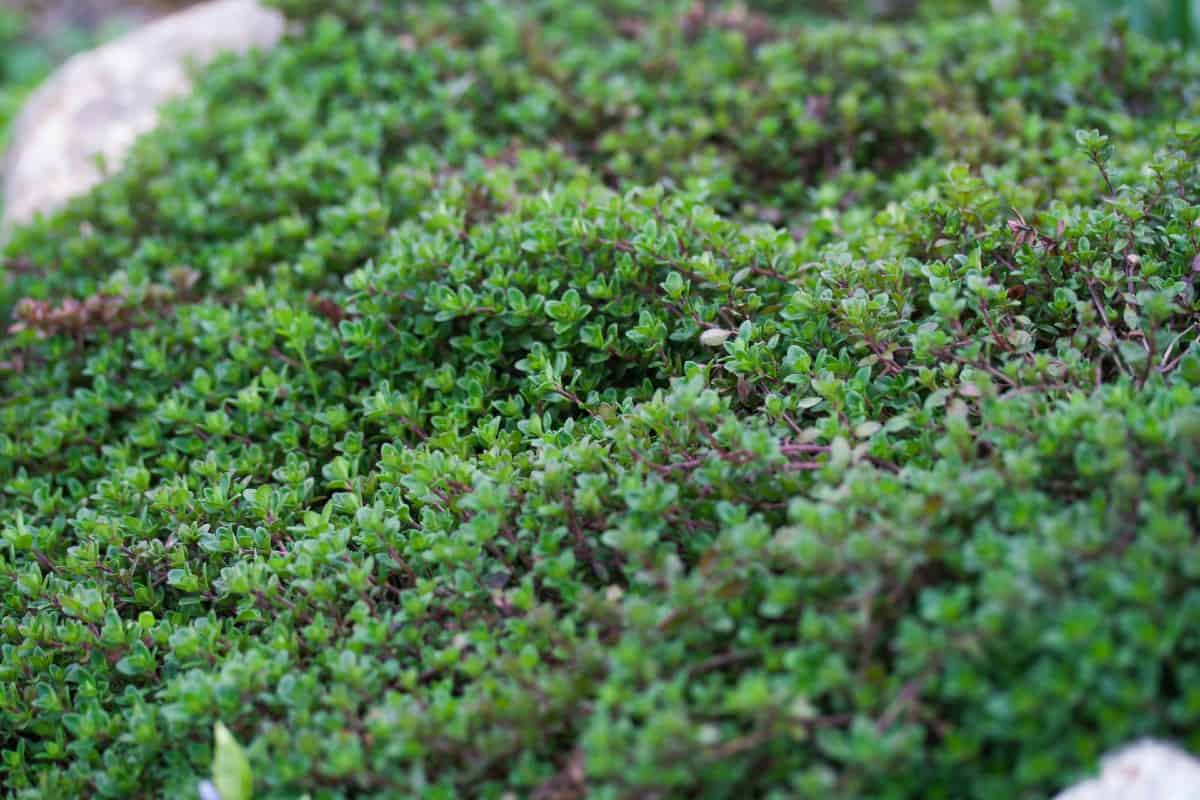
This low-lying woody perennial, a member of the mint family, has a strong scent and fine-textured leaves. In the late spring and early summer, creeping thyme displays small, pink-purple flowers.
Creeping thyme is popular for filling in cracks between paving stones or using as a grass alternative. However, it sprawls like a vine via both aboveground stolons and underground rhizomes.
This plant does best in full sun or part shade and either loam or sand. It’s partial to alkaline, well-drained, fertile soil but also tolerates poor-quality earth. The soil must not get too moist.
Creeping Phlox (Phlox subulata)

This hardy, low-growing perennial produces needle-like leaves and dense, star-shaped flowers of pink, white, blue, or purple. It grows in challenging locations, such as around rocks, and creeps with its runners to cover every available inch of space.
It’s easy to start creeping phlox plants in your yard using cuttings since this species puts down roots easily. This semi-evergreen loves full sun. It does well in sand or loam that’s well-drained and rich with humus. It does not enjoy soggy soil.
Periwinkle (Vinca minor)
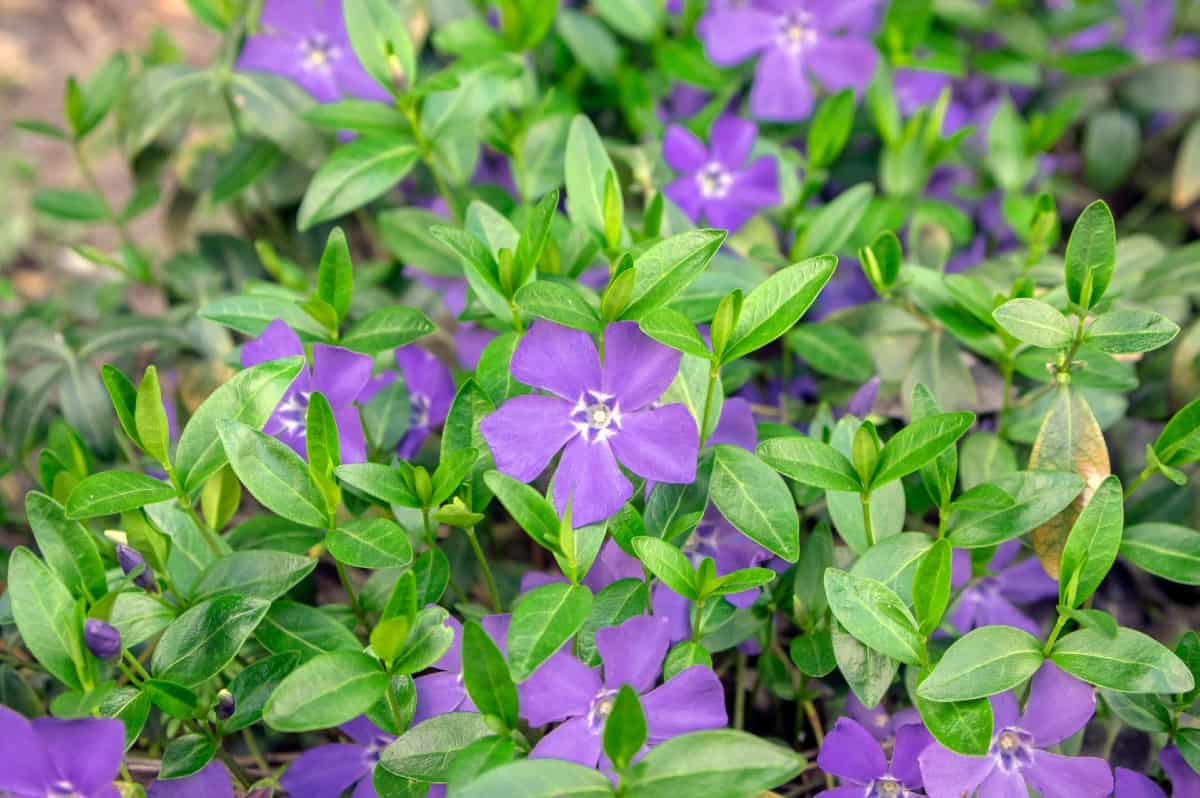
This semi-evergreen vine has slender stems and glossy, narrow leaves that may be variegated. In the spring, it bears five-petaled flowers of blue, violet, or white. Periwinkle produces narrow, dry fruit containing three to five infertile seeds.
Its roots often extend several feet below the earth’s surface. It expands quickly in full sun and moist, fertile soil, forming a dense mat that pushes out native plants.
As ground cover plants for wet areas, Periwinkle enjoys running riot in forests and near the sites of old houses.
Myrtle (Myrtus communis) – A Self-Fertilizing Invasive Ground Cover

This deer resistant evergreen shrub boasts small white or pink blossoms in July and August, then edible purplish-black berries. Its green leaves have a pleasant smell if you crush them.
This plant looks elegant in a hedge or woodland garden and is self-fertilizing, growing moderately quickly when it is young.
Myrtle puts up with some exposure to maritime conditions, such as salty air. Minimal water is required, and it blooms in full sun or partial shade. Myrtle is partial to slightly fertile, well-drained, neutral or alkaline soil.
Stringy Stonecrop (Sedum sarmentosum)
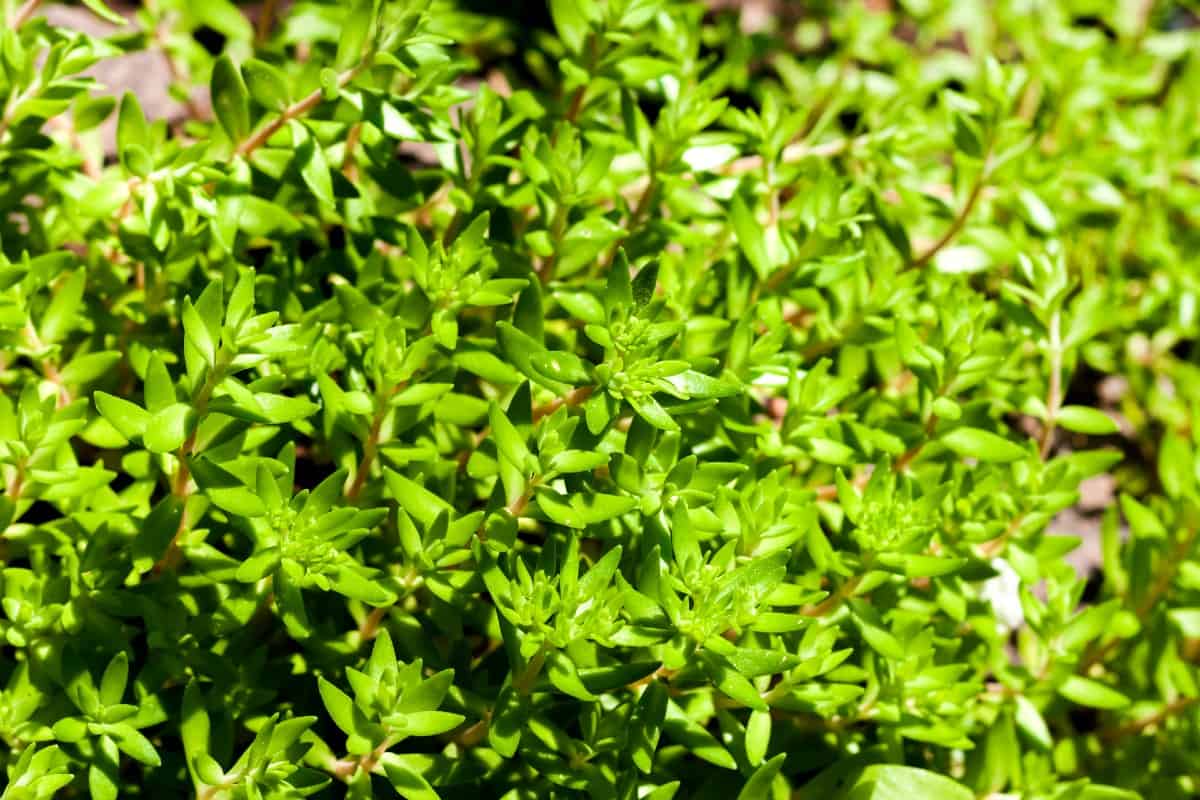
This low-growing perennial has small, succulent leaves and star-like yellow flowers. In mild regions, its leaves are green all year round, rather than turning red, russet, or bronze in the winter.
Stringy stonecrop develops quickly in difficult areas, including environments that are hot and dry or cold and alpine.
It grows well in partial shade or full sun as long as it receives at least six hours of direct sunlight. These drought tolerant ground covers invade dry, well-drained soil and manage quite well in poor-quality dirt.
Cushion Spurge (Euphorbia polychroma)

This long-lived plant chokes other plants with its dense leaves. In the fall, cushion spurge leaves turn red, purple, or orange. Its spring-blooming flowers are an unremarkable green, but the bracts at their base are bright yellow.
This hardy plant flourishes in full or partial sun in well-drained soil, including poor soil. A moderate quantity of water is sufficient. Cushion spurge self-seeds if it’s not deadheaded, also expanding aggressively via its rhizomes.
It’s worth noting that cushion spurge is highly toxic if eaten. Its milky sap can also irritate the skin and eyes.
Bishop’s Weed (Aegopodium podagraria) – A Leafy Invasive Ground Cover

This perennial has blue or green leaves and white flowers in the summertime. It sprouts readily, including in harsh conditions, reproducing via its many seeds. Bishop’s weed is difficult to eradicate since you must remove every plant and chunk of rhizome.
This plant prefers partial sun or shade, although it also does okay in full sun or shade. Ideally, bishop’s weed has moist, well-drained soil, although a little drought is acceptable. Pests and diseases do not tend to bother it.
Bugleweed (Ajuga reptans)
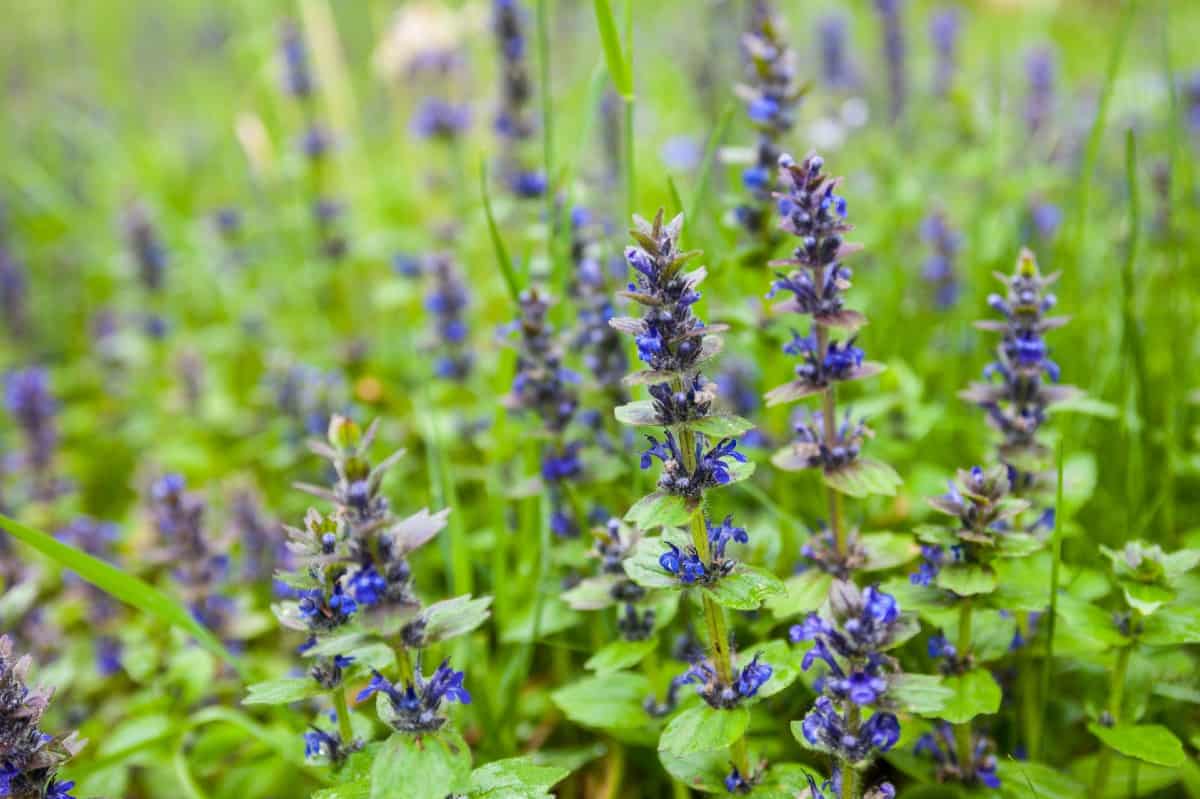
From May to June, this low-lying evergreen perennial displays tiny blue-violet flowers on its spikes. It also boasts shiny dark green leaves.
Bugleweed spreads aggressively via underground stolons that form new clumps near the parent plant. Its dense mat chokes out weeds but also desirable plants. If you do have a bugleweed plant, prune it twice a year to prevent it from taking over your yard.
This tough invader does well in full sun to part shade. It tolerates a range of temperatures but requires good air circulation in hot or humid conditions.
You’re likely to find this plant in a section of your garden with medium-moist, well-drained, fertile, somewhat acidic soil.
Chameleon Plant (Houttuynia cordata)

This tough perennial has a distinctive red, bronze, cream, or yellow border around its heart-shaped green leaves. The chameleon plant is also notable for smelling like diesel fuel. In June and July, it produces inconspicuous blooms.
As with other invasive ground covers, chameleon plants quickly take over. Its rhizomes extend deep and wide into the soil and break apart easily.
Every piece of rhizome sprouts into a new plant, so thoroughness is critical if you’re trying to remove the plant from your yard. The chameleonplant survives in soil that’s dry or moist or even poor quality. It thrives in either full sun or partial shade.
Mexican Evening Primrose (Oenothera berlandieri) – A Night-Blooming Invasive Ground Cover

As its name suggests, this perennial’s pale pink blossoms are only open from evening to mid-morning. North American indigenous groups have used evening primrose for treating bruises and wounds, while, today, people use the oil for treating conditions ranging from eczema to osteoporosis.
The root of these plants that grow fast is also edible raw or cooked, with a slight peppery flavor. Evening primrose proliferates aggressively via both seeds and plant growth. Make sure to divide the plant and cut back or deadhead its flowers to control growth.
Mexican evening primrose tolerates poor soil, although it prefers having plenty of organic matter. As a drought-tolerant plant, it flourishes in full sun with little water.
Artichoke Thistle (Cynara cardunculus)

This herbaceous perennial, also known as cardoon, has grey-green stalks with leaves that fan out in a circle, as well as smaller leaves higher up. In April to July, it bears blue or purple flowers. It’s worth noting that this thistle can cause contact dermatitis.
Its feathery brown or black seeds spread on the wind or animals’ bodies or during floods and survive up to five years. Artichoke thistle’s aggressive roots suck moisture and nutrients from the soil and outcompete native plants.
It runs riot rapidly in the springtime in clay and disturbed areas like roadsides. It favors full sun and well-drained soil.
German Ivy (Delairea odorata)
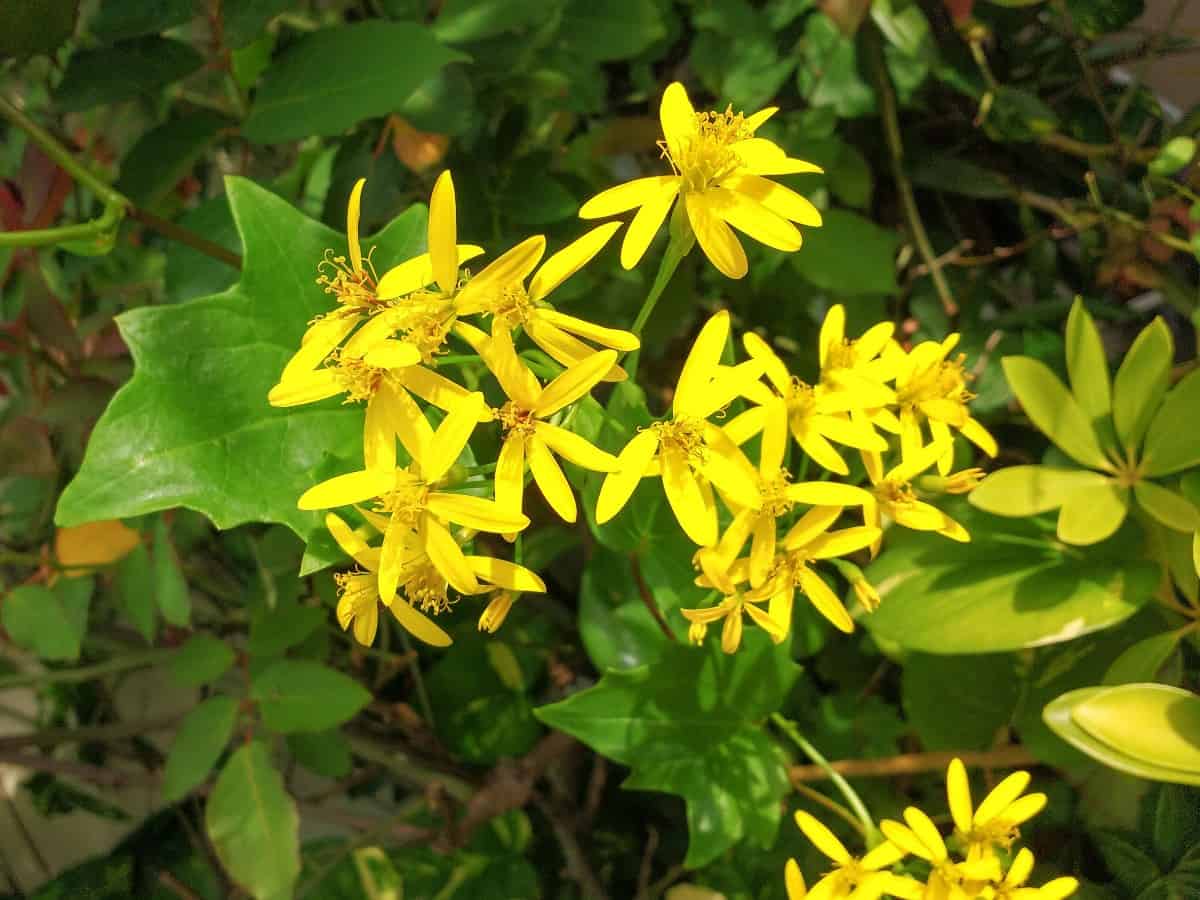
This vine has glossy, ivy-shaped leaves and thin, weak stems that scramble or climb. As the fastest spreading ground cover plant in some locations, it bears dense, stinky yellow flowers from May to October.
German ivy loves growing on forest and stream edges. It favors well-drained, fertile, moist soil and full sun to part shade. Watch out since this plant sends out new roots and shoots at its joints.
Its numerous fluffy seeds also disperse on the wind. German ivy is enough of a problem on its own, but, to make matters worse, it paves the way for more aggressive vines.
If you have a tricky spot in your garden, it’s understandable that you would turn to ground covers. After all, these species thrive in spaces where other plants struggle even to survive.
However, make sure to choose a native ground cover or at least one that’s easy to control. Invasive ground cover plants cause more of a headache than they’re worth as they take over your garden and refuse to leave.
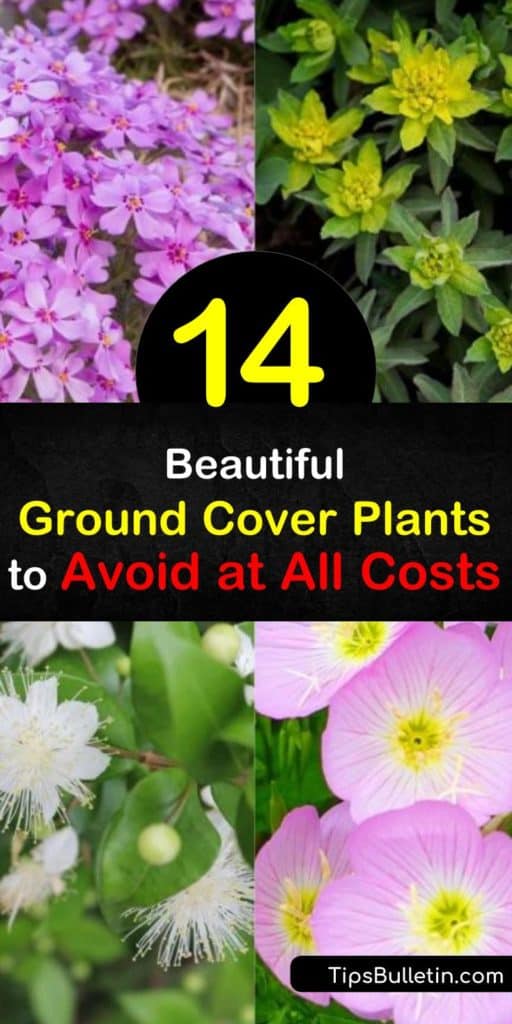
If you found this list of invasive ground covers useful, please share these gardening tips with your friends on Facebook and Pinterest.